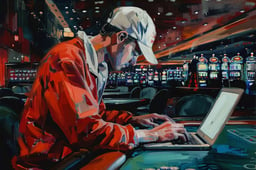Course
Microsoft Excel’s widespread usage in the business world makes it one of the most valuable tools you can use to clean, organize, and analyze data. With its built-in functions and formulas, data analysts can now easily apply statistical techniques even to estimate future trends and help in decision-making.
This tutorial will introduce you to one such built-in statistical function in Excel— CONFIDENCE, provide you with the syntax of its variants, and familiarize you with its usage.
This step-by-step guide includes screenshots and additional tips and resources to avoid the common errors faced , providing everything you need to learn about calculating confidence intervals using Excel.
What Are Confidence Intervals?
Confidence intervals are a range of values used in statistics to estimate the uncertainty around a sample statistic.
They provide a way to express the precision and reliability of an estimate from sample data.
Confidence intervals are typically associated with a confidence level, such as 95% or 99%. This confidence level indicates that if we were to take many samples and calculate confidence intervals similarly, 95% or 99% of these intervals would contain the true population parameter (e.g., the mean, proportion, or difference between means.)
For example, a 95% confidence interval for the mean of a population might be calculated as (20, 30). This means that we are 95% confident that the population's true mean lies between 20 and 30.
It’s important to note that this does not imply that there is a 95% probability that the true mean is in this interval; rather, it means that if we were to take many samples and calculate confidence intervals in the same way, 95% of those intervals would contain the true mean.
The Importance of Confidence Intervals in Data Analytics
Confidence intervals help decision-makers understand the range in which the true value of a population parameter is likely to lie, and the confidence level associated with this range, thus providing additional insights into the level of certainty in the results.
Consider a scenario where a data analyst is surveying to estimate the average number of hours people spend on a social media platform daily. After collecting data from a sample of 100 individuals, the analyst calculates the average to be 3 hours with a standard deviation of 1 hour. Using this information, the analyst computes a 95% confidence interval for the average time spent on social media, which turns out to be (2.8, 3.2) hours.
This confidence interval tells us that the analyst is 95% confident that the true average time spent on social media by the entire population lies between 2.8 and 3.2 hours. The importance of this confidence interval lies in its ability to quantify the uncertainty in the estimate. It provides a range of possible values for the true average, offering a more reliable understanding than a single-point estimate.
Decision-makers can use this information to develop social media strategies or policies, knowing the level of confidence in the estimated average time spent on the platform.
Learn Excel Fundamentals
Overview of the Confidence Interval Function in Excel
In Microsoft Excel, CONFIDENCE was originally the function that returns the confidence interval for a population mean. However, the function has been deprecated and replaced by two different functions, which are more accurate based on the purpose of the function. We must use the newer function as the old function may not exist in future versions of Excel.
The syntax and parameters for the CONFIDENCE.NORM function
The CONFIDENCE.NORM function in Excel is used to calculate the confidence interval for a population mean, assuming a normal distribution.
The syntax of the CONFIDENCE.NORM function is as follows:
=CONFIDENCE.NORM(alpha, standard_dev, size)The parameters are:
- alpha: The significance level (1 — confidence level). For example, for a 95% confidence interval, alpha would be 0.05.
- standard_dev: The standard deviation of the sample.
- size: The size of the sample.
The syntax and parameters for the CONFIDENCE.T function
The CONFIDENCE.T function in Excel is designed to calculate the confidence interval for a population mean, using the Student’s t-distribution.
The syntax of the CONFIDENCE.T function is:
=CONFIDENCE.T(alpha, standard_dev, size)The parameters are:
- alpha: The significance level (1 — confidence level).
- standard_dev: The standard deviation of the sample.
- size: The size of the sample.
When to use which confidence interval function?
In practice, if we’re unsure about the distribution of our population or when our sample size is small, it’s safer to use the CONFIDENCE.T function. When the standard deviation of a sample is not known, i.e., when we have to calculate the standard deviation ourselves, it’s best to use the CONFIDENCE.T function.
We typically use the CONFIDENCE.NORM function when:
- Our sample size is large.
- The population standard deviation is known (and not computed.)
- We’re confident that the distribution of the population is normal or we’re applying the Central Limit Theorem.
These guidelines can give you a better idea of when to use which function.
Now that we have learned everything about calculating confidence intervals in Excel, let’s put that into practice using an example.
How to Calculate Confidence Intervals in Excel: An Example
Consider a scenario where you, as a data analyst, are tasked with estimating the average response time (in hours) of a customer support team. The senior stakeholders want to assess the effectiveness of the customer support team.
As the analyst, you collect the response time data for a random sample of 40 customer inquiries. Then you tabulate the data in an Excel sheet as below (in hours):

Average response time data (This & all below screenshots by author)
Let’s step-by-step find the confidence interval:
- Step 1: Calculate Sample Mean. In a new cell, let’s say F6, use the AVERAGE function to calculate the sample mean.
=AVERAGE(A2:A41)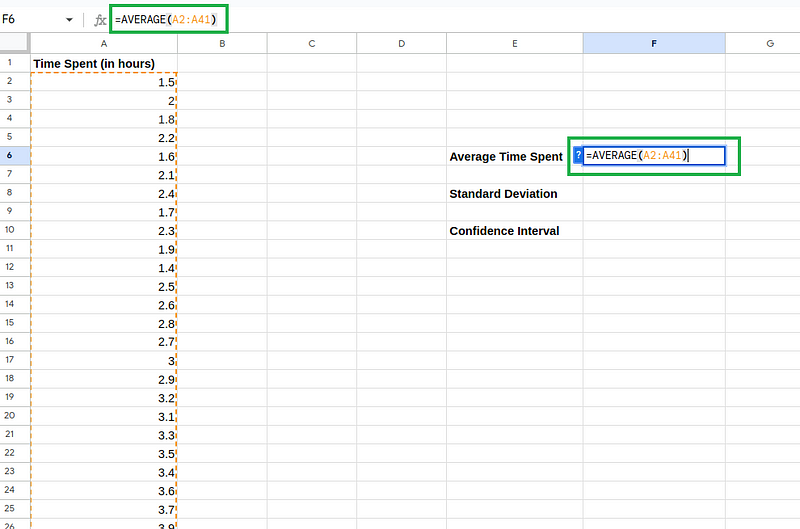 Calculating the sample mean.
Calculating the sample mean.
- Step 2: Calculate the standard deviation. Let’s say in cell F8, use the STDDEV.S function to calculate the sample standard deviation.
=STDEV.S(A2:A41)The reason for using STDEV.S (sample standard deviation) instead of STDEV.P (population standard deviation) is because we are working with a sample of data (as stated in the scenario) and not the entire population.
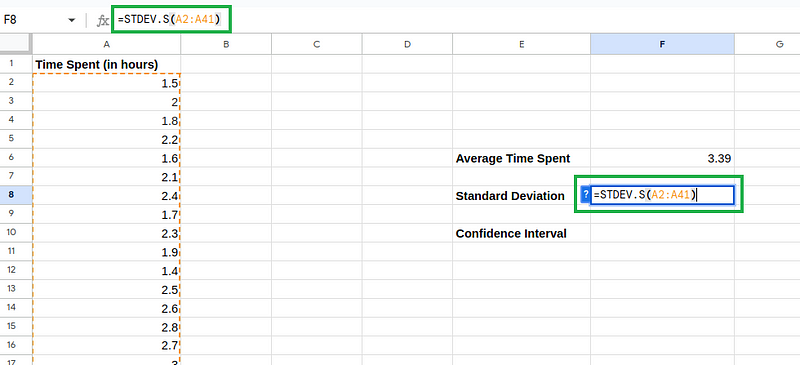
Calculating the sample deviation.
- Step 3: Calculating the margin of error. Let’s say, in cell F10, CONFIDENCE.T function to calculate the margin of error for a 95% confidence interval.
=CONFIDENCE.T(0.05, F8, 40)The reason for using the CONFIDENCE.T function for this example is because we didn’t know the standard deviation of the population before our analysis and had to calculate it ourselves.
We also don’t have information that the distribution is normal. Hence, the CONFIDENCE.T is the best-suited function for our scenario.
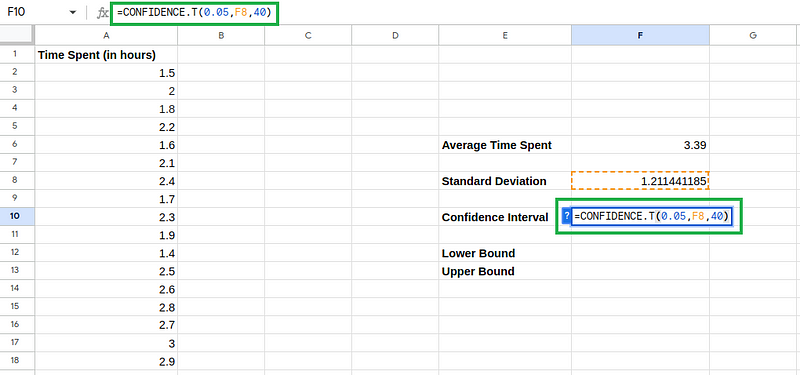
Calculating the margin of error.
- Step 4: Determine the confidence interval. The final confidence interval follows the process of finding the lower bound and the upper bound.
The lower bound can be calculated by:
LOWER BOUND =(SAMPLE MEAN - MARGIN OF ERROR)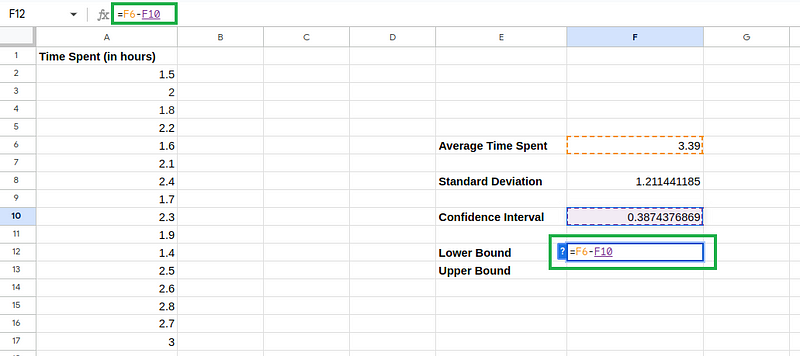
Calculating the upper bound.
Similarly, the upper bound can be calculated by:
UPPER BOUND =(SAMPLE MEAN + MARGIN OF ERROR)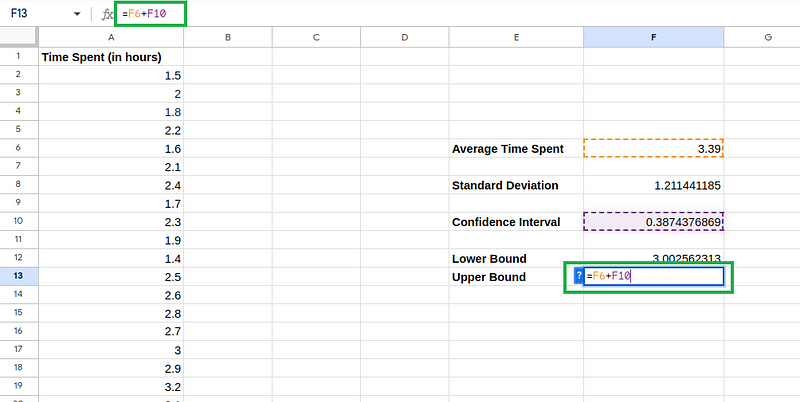
Calculating the lower bound
Now, we can report that with 95% confidence, the average response time of the customer support team lies between 3.00 hours and 3.77 hours, instead of merely giving the average value, which was 3.39 hours.
This information is valuable for the management to assess the performance of the support team, and make decisions regarding staffing, training, and process improvements to enhance customer satisfaction with more confidence.
Common Errors & How to Fix Them
When using the CONFIDENCE function in Excel, including its variants CONFIDENCE.NORM and CONFIDENCE.T, you may encounter the following typical issues:
#NUM! Error
The #NUM! error in Excel indicates a numerical problem with the formula. This error occurs if:
- the standard deviation is less than or equal to zero,
- the size of the sample is less than 2, or
- the alpha (significance level) is less than or equal to zero or greater than or equal to one.
A standard deviation of zero implies that all data points are identical, which is not meaningful for calculating a confidence interval. A negative standard deviation is mathematically impossible. If you’re using a pre-calculated standard deviation, ensure that it’s a positive number.
With a sample size of less than 2, it is not possible to calculate a meaningful estimate of the population mean or its variability. So, ensure you’re entering the correct sample size.
Choose an alpha value that is greater than 0 and less than 1. Common choices are 0.05 for a 95% confidence level, 0.01 for a 99% confidence level, and so on. Remember that alpha is generally a smaller value since it’s obtained after deducting the confidence level from 100%.
#VALUE! Error
The #VALUE! error in Excel signifies that there’s a problem with the values used in a formula. Concerning the confidence function, this error occurs if any of the arguments provided to the function are non-numeric.
Check that all the arguments (alpha, standard deviation, and sample size) are numeric values, and if you’re referencing cells, make sure they contain numeric data.
Of course, the error you encounter might be different from the above and unique — in that case, your best option is to check the Microsoft Answers forum for answered questions. You can also ask questions in the same forum to resolve your specific errors.
Conclusion
This tutorial introduced you to the concept of confidence intervals and its importance in data analytics. We then proceeded to understand the syntax of CONFIDENCE functions available in Excel and when to use them through a step-by-step guide for a probable real-world scenario.
The functions can get updated in the future, so the official Microsoft documentation is your best source of information.
Lastly, for comprehensive learning on leveraging Excel for data analytical skills, check out the Excel Fundamentals track, where you’ll start from being an absolute beginner to building your own customer churn analytics project in Excel.
We recommend checking our tutorial on basic Excel formulas and our Excel formulas cheat sheet for quick Excel references.
Advance Your Career with Excel
Gain the skills to maximize Excel—no experience required.

As a senior data scientist, I design, develop, and deploy large-scale machine-learning solutions to help businesses make better data-driven decisions. As a data science writer, I share learnings, career advice, and in-depth hands-on tutorials.
